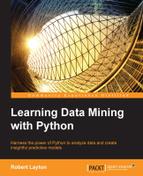We are collecting information at a scale that has never been seen before in the history of mankind and placing more day-to-day importance on the use of this information in everyday life. We expect our computers to translate Web pages into other languages, predict the weather, suggest books we would like, and diagnose our health issues. These expectations will grow, both in the number of applications and also in the efficacy we expect. Data mining is a methodology that we can employ to train computers to make decisions with data and forms the backbone of many high-tech systems of today.
The Python language is fast growing in popularity, for a good reason. It gives the programmer a lot of flexibility; it has a large number of modules to perform different tasks; and Python code is usually more readable and concise than in any other languages. There is a large and an active community of researchers, practitioners, and beginners using Python for data mining.
In this chapter, we will introduce data mining with Python. We will cover the following topics:
- What is data mining and where can it be used?
- Setting up a Python-based environment to perform data mining
- An example of affinity analysis, recommending products based on purchasing habits
- An example of (a classic) classification problem, predicting the plant species based on its measurement
Data mining provides a way for a computer to learn how to make decisions with data. This decision could be predicting tomorrow's weather, blocking a spam email from entering your inbox, detecting the language of a website, or finding a new romance on a dating site. There are many different applications of data mining, with new applications being discovered all the time.
Data mining is part of algorithms, statistics, engineering, optimization, and computer science. We also use concepts and knowledge from other fields such as linguistics, neuroscience, or town planning. Applying it effectively usually requires this domain-specific knowledge to be integrated with the algorithms.
Most data mining applications work with the same high-level view, although the details often change quite considerably. We start our data mining process by creating a dataset, describing an aspect of the real world. Datasets comprise of two aspects:
The next step is tuning the data mining algorithm. Each data mining algorithm has parameters, either within the algorithm or supplied by the user. This tuning allows the algorithm to learn how to make decisions about the data.
As a simple example, we may wish the computer to be able to categorize people as "short" or "tall". We start by collecting our dataset, which includes the heights of different people and whether they are considered short or tall:
|
Person |
Height |
Short or tall? |
|---|---|---|
|
1 |
155cm |
Short |
|
2 |
165cm |
Short |
|
3 |
175cm |
Tall |
|
4 |
185cm |
Tall |
The next step involves tuning our algorithm. As a simple algorithm; if the height is more than x, the person is tall, otherwise they are short. Our training algorithm will then look at the data and decide on a good value for x. For the preceding dataset, a reasonable value would be 170 cm. Anyone taller than 170 cm is considered tall by the algorithm. Anyone else is considered short.
In the preceding dataset, we had an obvious feature type. We wanted to know if people are short or tall, so we collected their heights. This engineering feature is an important problem in data mining. In later chapters, we will discuss methods for choosing good features to collect in your dataset. Ultimately, this step often requires some expert domain knowledge or at least some trial and error.
